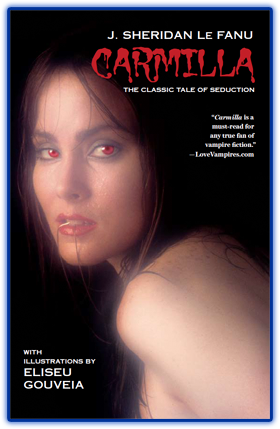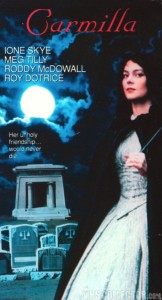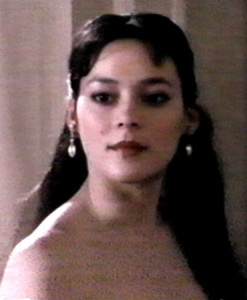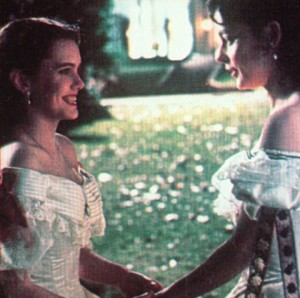 One hundred and forty-five years ago, J. Sheridan Le Fanu’s classic vampire tale, Carmilla, debuted in serialized form in the pages of the magazine Dark Blue—running from the December 1871 issue through March 1872—and was then reprinted in Le Fanu’s short story collection, In a Glass Darkly, published later that year.
One hundred and forty-five years ago, J. Sheridan Le Fanu’s classic vampire tale, Carmilla, debuted in serialized form in the pages of the magazine Dark Blue—running from the December 1871 issue through March 1872—and was then reprinted in Le Fanu’s short story collection, In a Glass Darkly, published later that year.
If you’re unfamiliar with what’s probably Le Fanu’s most famous work, here’s the back-cover copy from the edition that we published in 2010, which has become the most popular title in our Illustrated Classics line:
Before Edward and Bella, before Lestat and Louis, even before Dracula and Mina, there was the vampiric tale of Carmilla and Laura.
Living with her widowed father in a dreary old castle in the woods of Styria, Laura has longed to have a friend with whom she can confide; a friend to bring some excitement to her pastoral lifestyle. And then Carmilla enters her life.
Left by her mother in the care of Laura’s father, Carmilla is young, beautiful, playful—everything that Laura had hoped to find in a companion. In fact, the lonely girl is so thrilled to have a new friend that she is willing to overlook the dark-haired beauty’s strange actions…which include a disturbing, growing obsession for her lovely hostess.
Carmilla, it seems, desires more than just friendship from Laura….
The influence of Carmilla on horror fiction has lasted to this day, serving as an inspiration for numerous writers—including Bram Stoker in the creation of the vampire brides who threaten Jonathan Harker in Stoker’s seminal novel, Dracula. Carmilla has also been an inspiration for filmmakers, including actress/producer Shelly Duvall (The Shining, Popeye), who oversaw a cable television adaptation in the late eighties.
 In September 1989, the short-lived Showtime series Nightmare Classics—aka Shelley Duvall’s Nightmare Classics, since the actress created and produced it—adapted Le Fanu’s tale, moving the action to a post–Civil War plantation and casting Meg Tilly (Psycho II, The Big Chill) as Carmilla, Ione Skye (Haunt, Say Anything…) as Laura, here named Marie, and Roy Dotrice (TV’s Beauty and the Beast) as Marie’s father, Leo.
In September 1989, the short-lived Showtime series Nightmare Classics—aka Shelley Duvall’s Nightmare Classics, since the actress created and produced it—adapted Le Fanu’s tale, moving the action to a post–Civil War plantation and casting Meg Tilly (Psycho II, The Big Chill) as Carmilla, Ione Skye (Haunt, Say Anything…) as Laura, here named Marie, and Roy Dotrice (TV’s Beauty and the Beast) as Marie’s father, Leo.
Since his wife ran off with a Yankee after the war ended, Leo has turned Marie into a shut-in with no friends—until the carriage carrying Carmilla and her “mother” crashes near the home. It doesn’t take long for the two girls to become close—close enough for Carmilla to start turning Marie against Leo, and to convince Marie to become a willing victim of her vampiric bestie. The only one who seems to know what Carmilla really is is Miss Hodgett (Armelia McQueen), the housekeeper. Carmilla puts an end to her suspicions by unleashing a horde of bats on Miss Hodgett—or at least a horde of bat shadows on a wall, given the show’s budgetary limitations—that bite her to death…or as much biting as a stack of rubber bats glued to her face can do…

Meg Tilly as Carmilla
Inspector Amos (Roddy McDowall) then arrives on the scene to investigate and immediately realizes what’s going on—and who would know better when a vampire is involved than the actor who played TV horror host Peter Vincent in the original Fright Night? But can he do anything to stop Carmilla from claiming Marie when Marie appears only too willing to become a vampire herself if it means she and Carmilla can be friends forever…?
Moving the action to the American South doesn’t really add anything to the story, except maybe help keep the show’s budget within reason—if there’s one thing America isn’t lacking in it’s Civil War–era costuming and plantation-style houses—but making Marie more outspoken and willful than novella-Laura is a step in the right direction—and a bold one to take—from the source material. Carmilla might be a strong influence over Marie, and Marie might be only a food source to her, but we can see through Skye’s portrayal that the spark to rebel was always in Marie—her dad-influenced shut-in status put her in that position. Carmilla’s just there to give her that final nudge toward independence (although the ending doesn’t really make it clear if she’s going to follow-up on her emboldened status).

Ione Skye (l.) and Meg Tilly
As Carmilla, Tilly is soft-spoken and delicate—a Southern belle given to sly, knowing smiles when no one’s watching. She’s a quiet threat, never raising her voice or acting wildly as she methodically eliminates any obstacles blocking her way to Marie—but does she really love the girl, or merely see her as a beautiful meal? Despite her flowery speeches about loving Marie and urging her to see the world, we’re never certain if this vampire is capable of true love. But Tilly is definitely Dotrice’s equal in the scenes they share.
Bottom line? Nightmare Classics might have been canceled by Showtime after four episodes, but their adaptation of Carmilla is one that fans of Le Fanu’s work should definitely catch. You can watch the episode over at YouTube. Go give it a view.
Nightmare Classics: Carmilla (1989)
Starring Meg Tilly, Ione Skye, Roy Dotrice, and Roddy McDowall
Directed by Gabrielle Beaumont
Screenplay by Jonathan Furst
Produced by Think Entertainment
Carmilla—the SWC Illustrated Classics edition, which features six original drawings by Eliseu Gouveia—is available in print and digital formats, so visit its product page for ordering information.







Pingback: Carmilla the Nightmare Classic | The Saga of Pandora Zwieback